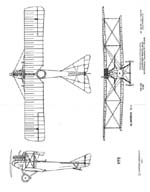Choroszy Modelbud 1/72 Albatros C.Ia By Grzegorz Mazurowski |  | Introduction  The first of the long line of famous and widely used Albatros C planes, the Albatros C.I was an armed and slightly modified version of the older Albatros B.II, one of the main workhorses of the German aviation in the first years of World War One. The biggest change, which turned B.II into C.I, was swapping the places of the pilot and the gunner/observer. Primarily, like in the majority of the contemporary two-seaters, the observer occupied the front seat, placed between the wings, which prevented him from effective operation of the defensive machine gun. In the Albatros C.I the observer was moved to the backseat and equipped with the Parabellum MG. This marked the beginning of a new class of airplanes, the so called "type C". The first of the long line of famous and widely used Albatros C planes, the Albatros C.I was an armed and slightly modified version of the older Albatros B.II, one of the main workhorses of the German aviation in the first years of World War One. The biggest change, which turned B.II into C.I, was swapping the places of the pilot and the gunner/observer. Primarily, like in the majority of the contemporary two-seaters, the observer occupied the front seat, placed between the wings, which prevented him from effective operation of the defensive machine gun. In the Albatros C.I the observer was moved to the backseat and equipped with the Parabellum MG. This marked the beginning of a new class of airplanes, the so called "type C". The Kit Packed in the "top-bottom' type of the cardboard box, the kit contains 66 parts moulded in the light tan resin. Quality of the casting is very high, and only a few air bubbles are present, the biggest ones in my kit are in the rudder and in the rear part of one of the fuselage halves, as you can see on the scans. Another minor faults are a few very delicate scratches on the wing surfaces caused by the matchstick used during filling the mould, nothing difficult to remove with a bit of sanding (maybe even good coating with the paint will be enough?). Level of the details is also impressive. Wing surfaces have very delicate main and auxiliary ribs. Small and delicate details are many and very good, and the most impressive IMHO is the detailing of the fuselage interior: all the visible through the cockpit hole fuselage formers, bomb tubes, and even the throttle quadrant are present, and very well depicted. Kit contains also a small clear styrene sheet to make the windscreen, set of the precisely printed very thin decals allowing the modeler to build the kit in two schemes, post-war Polish and 1917 German, and the instruction sheets, which includes precise airplane plans, marking instructions for the both schemes, and nicely drawn exploded view of the kit, showing where all that tiny bits should be attached. Also short history of the type is given, with the basic specifications and technical data. Conclusion Very high quality of the parts, number of the details and general good 'engineering' of this kit makes it an excellent product, although, like any resin kit, it is not suited for a beginner. For the more experienced modeler, not afraid of using the CA glue and aligning the two-bay wing cellule, it is one of the best resin kits one can get. Photos of the completed kit in the Polish markings you can see on the producer's website where you can also order this kit for yourself. I would like to thank the manufacturer, Tomasz Choroszy, for the review kit. | 








|
